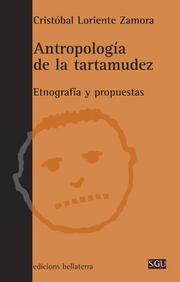
Antropología de la tartamudez
By Cristóbal Loriente Zamora
Subjects: Medical anthropology, Stuttering
Description: INDEX PREFACE I-. Introduction. II-. Methodology and field work. 1-. Methodology. 1.1-. Reflexivity of knowledge and methodological pluralism. 1.2-. Qualitative methodology. 1-. Definition. 2-. Qualitative research techniques. 2.1-. Participant observation. 2.2-. The Interview. 2.3-. Field annotations. 1.3-. Quantitative methodology. 2-. Field work. 2.1-. Introduction. 2.2-. Description of field work. 1-. Phases and ethnographic content. 2-. Data gathering techniques. 2.1-. Participant observation. 1-. In virtual groups. 2-. In self-help groups. 2.2-. Interviews. 2.3-. Field work annotations. 2.4-. Survey. III-. Stuttering as a sociocultural construct. 1-. Introduction. 2-. Basic historical considerations. 2.1-. From antiquity to the XX century. 2.2-. From the beginning of the XX century until 1987. 1-. Introduction. 2-. Logopedic methodology. 3-. Psicoanalisis. 4-. Personality. 5-. Scientific research. 5.1-. Organic biology hypothesis. 1-. Predomiance Deficit theory. 2-. Alteration of the speech mechanisms self-control. 3-. Difficulties in the neuromuscular coordination. 4-. Lack of coordination between the respiratory and phonoarticulatory systems. 5.2-. Psychological hypothesis. 1-. Diagnosogenic theory. 2-. Sheehan’s Theory. 3-. Van Riper’s theory. 6-. Conclusion. 2.3-. From 1987 to the present day. 1-. Introduction. 2-. Starkweather’ theory of capacities and demands. 3-. Bloodstein’s hypothesis of anticipatory avoidance. 4-. Friedman’s confidence . 3-. Criticism of biomedical stuttering. 3.1-. Classification and criticism of biomedic definitions of suttering. 1-. Definitions from the point of view of the hearer. 2-. Definitions from the point of view of the speaker. 3.2-. Sociocultural construction of stuttering disfluencies. 3.3-. From the Biopsicosocio a to the Sociopsicobio. 1-. Introduction. 2-. Social construction of stuttering. 2.1-. Introduction. 2.2-. Medicalization. 2.3-. Stigmatization 4-. Conclusions. IV-. Personal identity of the stuttering community. 1-. Introducción. 2-. Feelings on the wound of the difference. 2.1-. Introduction. 2.2-. Defencelessness. 2.3-. Avoidance. 2.4-. Shame. 2.5-. Guilt. 1-. Description and theoretical analysis. 2-. Criticims of Sheehan¡ concept ofguilt. 2.1-. provoked guilt. 1-. Guilty myths. 2-. Innocent myths. 2.2-. The guilt of the false role. 2.3-. Guilt from audience reaction. 3-. Ethnographic analysis of guilt. 2.6-. Fear. 1-. Introduction and theoretical and practical example. 2-. Theoretical analysis. 2.1-. Wendell Johnson. 2.2-. Van Riper. 3-. Ethnographic analysis of fear. 3.1-. Fear of speaking (and stuttering). 3.2-. Fear of social relationships. 3.3-. Fear of genetic transmission. 4-. Consequences of fear. 3-. Thoughts of the wound of the difference. 4-. Compound elements: the self-concept. 5-. Pride. 6-. Conclusions. V-. Coming Out. 1-. Introduction. 2.-. The group as an open system. 2.1-. In-group favouritism. 2.2-. Intergroupal conflicto. 1-. Introduction. 2-. Stereotype. 3-. Discrimination. 2.3-. Social identity. 1-. Concept. 2-. Shared beliefs. 2.1-. Ethnogprahic comparisons. 2.2-. Theoretical analysis. 1-. Stigma and hiding stuttering. 2-. Destigmatization of homosexuality. 3-. Emancipation Project: Coming Out. 3.1-. Introduction. 3.2-. Ideary. 3.3-. Objectives and mutual interdependence. 3.4-. Meaning and concept. 3.5-. Ethnographic testimony. 3.6-. Personal Coming Out. 1-. Phases: theoretical and ethnographic analysis. 1.1-. Introduction. 1.2-. Analisys. 2-. Consequences. 3.7-. Dignification of stuttering. 1-. Causal inversion. 2-. Ethnographic testimony. 4-. Reconstruction of stuttering. 4.1-. Introduction. 4.2-. Specific consequences of traditional construct. 4.3-. transfluency 1-. Two basic principles of biomedicine. 1.1-. Dual ontological opposition. 1.2-. Medicalization of the difference. 2-. Transfluency: concept and characteristics. VI-. Conclusions. VII-. Bibliography.
Comments
You must log in to leave comments.